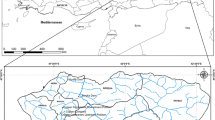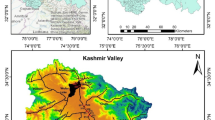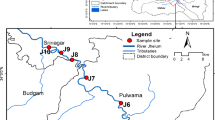Abstract
This case study uses several univariate and multivariate statistical techniques to evaluate and interpret a water quality data set obtained from the Klang River basin located within the state of Selangor and the Federal Territory of Kuala Lumpur, Malaysia. The river drains an area of 1,288 km2, from the steep mountain rainforests of the main Central Range along Peninsular Malaysia to the river mouth in Port Klang, into the Straits of Malacca. Water quality was monitored at 20 stations, nine of which are situated along the main river and 11 along six tributaries. Data was collected from 1997 to 2007 for seven parameters used to evaluate the status of the water quality, namely dissolved oxygen, biochemical oxygen demand, chemical oxygen demand, suspended solids, ammoniacal nitrogen, pH, and temperature. The data were first investigated using descriptive statistical tools, followed by two practical multivariate analyses that reduced the data dimensions for better interpretation. The analyses employed were factor analysis and principal component analysis, which explain 60 and 81.6 % of the total variation in the data, respectively. We found that the resulting latent variables from the factor analysis are interpretable and beneficial for describing the water quality in the Klang River. This study presents the usefulness of several statistical methods in evaluating and interpreting water quality data for the purpose of monitoring the effectiveness of water resource management. The results should provide more straightforward data interpretation as well as valuable insight for managers to conceive optimum action plans for controlling pollution in river water.







Similar content being viewed by others

References
Basilevsky, A.T. (2009). Statistical factor analysis and related methods: theory and applications: Wiley.
COD or Chemical Oxygen Demand definition (2009). The Laboratory People. http://camblab.info/wp/index.php/272/. Accessed 2013.
Covington, A. K., Whalley, P. D., & Davison, W. (1985). Recommendations for the determination of pH in low ionic strength fresh waters. Pure and Applied Chemistry, 57(6), 877–886.
Cude, C. G. (2001). Oregon water quality index a tool for evaluating water quality management effectiveness. JAWRA Journal of the American Water Resources Association, 37(1), 125–137. doi:10.1111/j.1752-1688.2001.tb05480.x.
Ell, M.J. (2008). Total suspended solids (TSS). In N. D. D. O. Health (Ed.), North Dakotan, USA.
Fulazzaky, M. A. (2010). Water quality evaluation system to assess the status and the suitability of the Citarum river water to different uses. Environmental Monitoring and Assessment, 168(1–4), 669–684. doi:10.1007/s10661-009-1142-z.
Gabriel, K. R. (1971). The biplot graphic display of matrices with application to principal component analysis. Biometrika, 58(3), 453–467. doi:10.1093/biomet/58.3.453.
Ibarahim, R., & Lee, C. M. (2004). Pollution prevention and river water quality improvement programme. Buletin Ingenieur, 23, 6–7.
Ji, Z.G. (2008). Hydrodynamics and water Quality: modeling rivers, lakes, and estuaries: Wiley-Interscience.
Johnson, R.A., & Wichern, D.W. (2002). Applied multivariate statistical analysis. (5th ed., pp. 767): Prentice Hall.
Jolliffe, I. T. (2002). Principal component analysis. New York, USA: Springer.
Juahir, H., Zain, S. M., Aris, A. Z., Yusoff, M. K., & Mokhtar, M. B. (2009). Spatial assessment of Langat River water quality using chemometrics. Journal of Environmental Monitoring, 12(1), 287–295.
Juahir, H., Zain, S. M., Yusoff, M. K., Hanidza, T. I., Armi, A. S., Toriman, M. E., et al. (2011). Spatial water quality assessment of Langat River basin (Malaysia) using environmetric techniques. Environmental Monitoring and Assessment, 173(1–4), 625–641. doi:10.1007/s10661-010-1411-x.
Kazi, T. G., Arain, M. B., Jamali, M. K., Jalbani, N., Afridi, H. I., Sarfraz, R. A., et al. (2009). Assessment of water quality of polluted lake using multivariate statistical techniques: a case study. Ecotoxicology and Environmental Safety, 72(2), 301–309. doi:10.1016/j.ecoenv.2008.02.024.
Koklu, R., Sengorur, B., & Topal, B. (2009). Water quality assessment using multivariate statistical methods—a case study: Melen River system (Turkey). Water Resources Management, 24(5), 959–978. doi:10.1007/s11269-009-9481-7.
Kwok, N.-Y., Dong, S., Lo, W., & Wong, K.-Y. (2005). An optical biosensor for multi-sample determination of biochemical oxygen demand (BOD). Sensors and Actuators B: Chemical, 110(2), 289–298. doi:10.1016/j.snb.2005.02.007.
Lapong, E., Fujihara, M., Izumi, T., Kobayashi, N., Kakihara, T., Hamagami, K. (2012). Water quality index and statistical analysis methods for water quality characterization in agricultural rivers. Paper presented at the Water Quality 2012, Hangzhou, China, 19–21 September
Liu, C.-W., Lin, K.-H., & Kuo, Y.-M. (2003). Application of factor analysis in the assessment of groundwater quality in a blackfoot disease area in Taiwan. Science of the Total Environment, 313(1–3), 77–89. doi:10.1016/s0048-9697(02)00683-6.
Mirmohseni, A., & Oladegaragoze, A. (2003). Construction of a sensor for determination of ammonia and aliphatic amines using polyvinylpyrrolidone coated quartz crystal microbalance. Sensors and Actuators B-Chemical, 89(1–2), 164–172. doi:10.1016/S0925-4005(02)00459-8.
Mustapha, A., Aris, A. Z., Juahir, H., Ramli, M. F., & Kura, N. U. (2013). River water quality assessment using environmentric techniques: case study of Jakara River basin. Environmental Science and Pollution Research International, 20(8), 5630–5644. doi:10.1007/s11356-013-1542-z.
Nduka, J. K., & Orisakwe, O. E. (2011). Water-quality issues in the Niger Delta of Nigeria: a look at heavy metal levels and some physicochemical properties. Environmental Science and Pollution Research International, 18(2), 237–246. doi:10.1007/s11356-010-0366-3.
Nives, S.-G. (1999). Water quality evaluation by index in Dalmatia. Water Research, 33(16), 3423–3440.
Othman, F., Alaa-Eldin, M. E., & Mohamed, I. (2012). Trend analysis of a tropical urban river water quality in Malaysia. Journal of Environmental Monitoring, 14(12), 3164–3173. doi:10.1039/C2EM30676J.
Pandey, M., & Sundaram, S. M. (2002). Trend of water quality of river Ganga at Varanasi using WQI approach. International Journal of Ecology and Environmental Science of the Total Environment, 28, 139–142.
Qadir, A., Malik, R. N., & Husain, S. Z. (2008). Spatio-temporal variations in water quality of Nullah Aik-tributary of the river Chenab, Pakistan. Environmental Monitoring and Assessment, 140(1–3), 43–59. doi:10.1007/s10661-007-9846-4.
Rahman, H. A. (2007). A survey on a river pollution in Malaysia. In Geographic Conference, USPI, Malaysia.
Shuhaimi-Othman, M., Lim, E. C., & Mushrifah, I. (2007). Water quality changes in Chini Lake, Pahang, West Malaysia. Environmental Monitoring and Assessment, 131(1–3), 279–292. doi:10.1007/s10661-006-9475-3.
Simon, F. X., Penru, Y., Guastalli, A. R., Llorens, J., & Baig, S. (2011). Improvement of the analysis of the biochemical oxygen demand (BOD) of Mediterranean seawater by seeding control. Talanta, 85(1), 527–532. doi:10.1016/j.talanta.2011.04.032.
Singh, K. P., Malik, A., Mohan, D., & Sinha, S. (2004). Multivariate statistical techniques for the evaluation of spatial and temporal variations in water quality of Gomti River (India)—a case study. Water Research, 38(18), 3980–3992. doi:10.1016/j.watres.2004.06.011.
Snyder, J. (2007). Dissolved Oxygen. http://www.seagrant.sunysb.edu/oli/Water%20Quality/DissolvedOxygen.html2013.
Swaroop Bhargava, D. (1983). Use of water quality index for river classification and zoning of Ganga River. Environmental Pollution Series B, Chemical and Physical, 6(1), 51–67.
TIBCO Spotfire S+® 8.1 (2008). Guide to Statistics. (Vol. 1, pp. 718): TIBCO Software Inc.
Varol, M., Gokot, B., & Bekleyen, A. (2013). Dissolved heavy metals in the Tigris River (Turkey): spatial and temporal variations. Environmental Science and Pollution Research International, 20(9), 6096–6108. doi:10.1007/s11356-013-1627-8.
Vialle, C., Sablayrolles, C., Lovera, M., Jacob, S., Huau, M. C., & Montrejaud-Vignoles, M. (2011). Monitoring of water quality from roof runoff: interpretation using multivariate analysis. Water Research, 45(12), 3765–3775. doi:10.1016/j.watres.2011.04.029.
Viessman, W., & Hammer, M. J. (2005). Water supply and pollution control (7th edn.). The University of Michigan. USA: Pearson Prentice Hall.
Wang, Y., Wang, P., Bai, Y., Tian, Z., Li, J., Shao, X., et al. (2013). Assessment of surface water quality via multivariate statistical techniques: a case study of the Songhua river Harbin region, china. Journal of Hydro-Environment Research, 7(1), 30–40. doi:10.1016/j.jher.2012.10.003.
Yidana, S. M., & Yidana, A. (2009). Assessing water quality using water quality index and multivariate analysis. Environmental Earth Sciences, 59(7), 1461–1473. doi:10.1007/s12665-009-0132-3.
Acknowledgments
We would like to express our thanks to the Department of Irrigation and Drainage and the Department of Environment, Malaysia for their cooperation when we conducted this study. This research is financially supported by the Research Grant (No: RG244-12AFR, RP009C-13AFR, FL001-13SUS) from the University of Malaya. We are most grateful and would like to thank the reviewers for their valuable suggestions, which led to a substantial improvement of the article.
Author information
Authors and Affiliations
Corresponding author
Rights and permissions
About this article
Cite this article
Mohamed, I., Othman, F., Ibrahim, A.I.N. et al. Assessment of water quality parameters using multivariate analysis for Klang River basin, Malaysia. Environ Monit Assess 187, 4182 (2015). https://doi.org/10.1007/s10661-014-4182-y
Received:
Accepted:
Published:
DOI: https://doi.org/10.1007/s10661-014-4182-y



